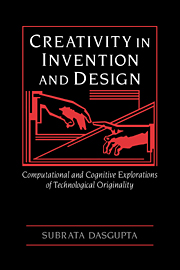Book contents
- Frontmatter
- Contents
- Preface
- Acknowledgments
- Part I Creativity in invention and design: issues and ingredients
- Part II The invention of microprogramming: a cognitive explanation
- Part III Reflections on the nature of inventing
- 7 Eight hypotheses about the nature of inventing
- 8 Epilogue
- Appendix
- References
- Index
7 - Eight hypotheses about the nature of inventing
Published online by Cambridge University Press: 23 December 2009
- Frontmatter
- Contents
- Preface
- Acknowledgments
- Part I Creativity in invention and design: issues and ingredients
- Part II The invention of microprogramming: a cognitive explanation
- Part III Reflections on the nature of inventing
- 7 Eight hypotheses about the nature of inventing
- 8 Epilogue
- Appendix
- References
- Index
Summary
There we have it: an account – an explanation – of how a particular act of inventive design in the domain of one particular science of the artificial might have taken place. The explanation takes the form of a computation at the level of cognitive description known as the knowledge level. Just as the proof of a theorem stated as an organized, stepwise set of arguments is an explanation of why the theorem is (believed or should be believed by an individual or community to be) true, so also our explanation takes the form of a symbolic process – that is, a structured set of symbol-transforming actions. Extending this parallel further, just as a mathematical argument draws on a body of assertions (axioms, lemmas, and theorems) that are assumed or known to be true prior to the onset of the argument or are produced along the way, so also the process described in these pages appeals to a corpus of knowledge the tokens of which are in part postulated to have existed at the time Maurice Wilkes began to think about the problem and in part generated by the process itself.
Let us, at this stage, recall a point already emphasized in Chapters 1 and 4. Historical episodes of a certain type bear the stamp of contingency. Past episodes of cognitive acts such as the invention of a theory or the design of a new type of artifact belong to this category. Thus, any explanation of such an episode will inherit the burden of contingency. We can hardly ever claim that the episode must have happened in one particular way rather than some other.
- Type
- Chapter
- Information
- Creativity in Invention and Design , pp. 189 - 212Publisher: Cambridge University PressPrint publication year: 1994



